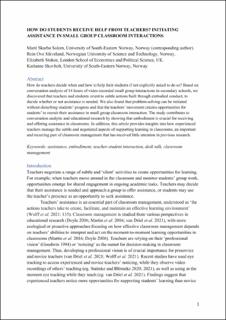| dc.contributor.author | Solem, Marit Skarbø | |
| dc.contributor.author | Sikveland, Rein Ove | |
| dc.contributor.author | Stokoe, Elizabeth | |
| dc.contributor.author | Skovholt, Karianne | |
| dc.date.accessioned | 2024-04-04T08:19:06Z | |
| dc.date.available | 2024-04-04T08:19:06Z | |
| dc.date.created | 2023-12-12T11:17:01Z | |
| dc.date.issued | 2023 | |
| dc.identifier.issn | 0142-6001 | |
| dc.identifier.uri | https://hdl.handle.net/11250/3124755 | |
| dc.description.abstract | How do teachers decide when and how to help their students if not explicitly asked to do so? Based on conversation analysis of 14 hours of video-recorded small group interactions in secondary schools, we discovered that teachers and students orient to subtle actions built through embodied conduct, to decide whether or not assistance is needed. We also found that problem-solving can be initiated without disturbing students’ progress and that the teachers’ movement creates opportunities for students’ to recruit their assistance in small group classroom interaction. The study contributes to conversation analytic and educational research by showing that embodiment is crucial for receiving and offering assistance in classrooms. In addition, this article provides insights into how experienced teachers manage the subtle and negotiated aspects of supporting learning in classrooms, an important and recurring part of classroom management that has received little attention in previous research. | en_US |
| dc.description.abstract | How do students receive help from teachers? Initiating assistance in small group classroom interactions | en_US |
| dc.language.iso | eng | en_US |
| dc.publisher | Oxford University Press | en_US |
| dc.rights | Navngivelse 4.0 Internasjonal | * |
| dc.rights.uri | http://creativecommons.org/licenses/by/4.0/deed.no | * |
| dc.title | How do students receive help from teachers? Initiating assistance in small group classroom interactions | en_US |
| dc.title.alternative | How do students receive help from teachers? Initiating assistance in small group classroom interactions | en_US |
| dc.type | Journal article | en_US |
| dc.type | Peer reviewed | en_US |
| dc.description.version | acceptedVersion | en_US |
| dc.source.pagenumber | 1-16 | en_US |
| dc.source.volume | XX | en_US |
| dc.source.journal | Applied Linguistics | en_US |
| dc.identifier.doi | 10.1093/applin/amad079 | |
| dc.identifier.cristin | 2212246 | |
| dc.relation.project | Norges forskningsråd: 273417 | en_US |
| cristin.ispublished | true | |
| cristin.fulltext | postprint | |
| cristin.qualitycode | 2 | |

